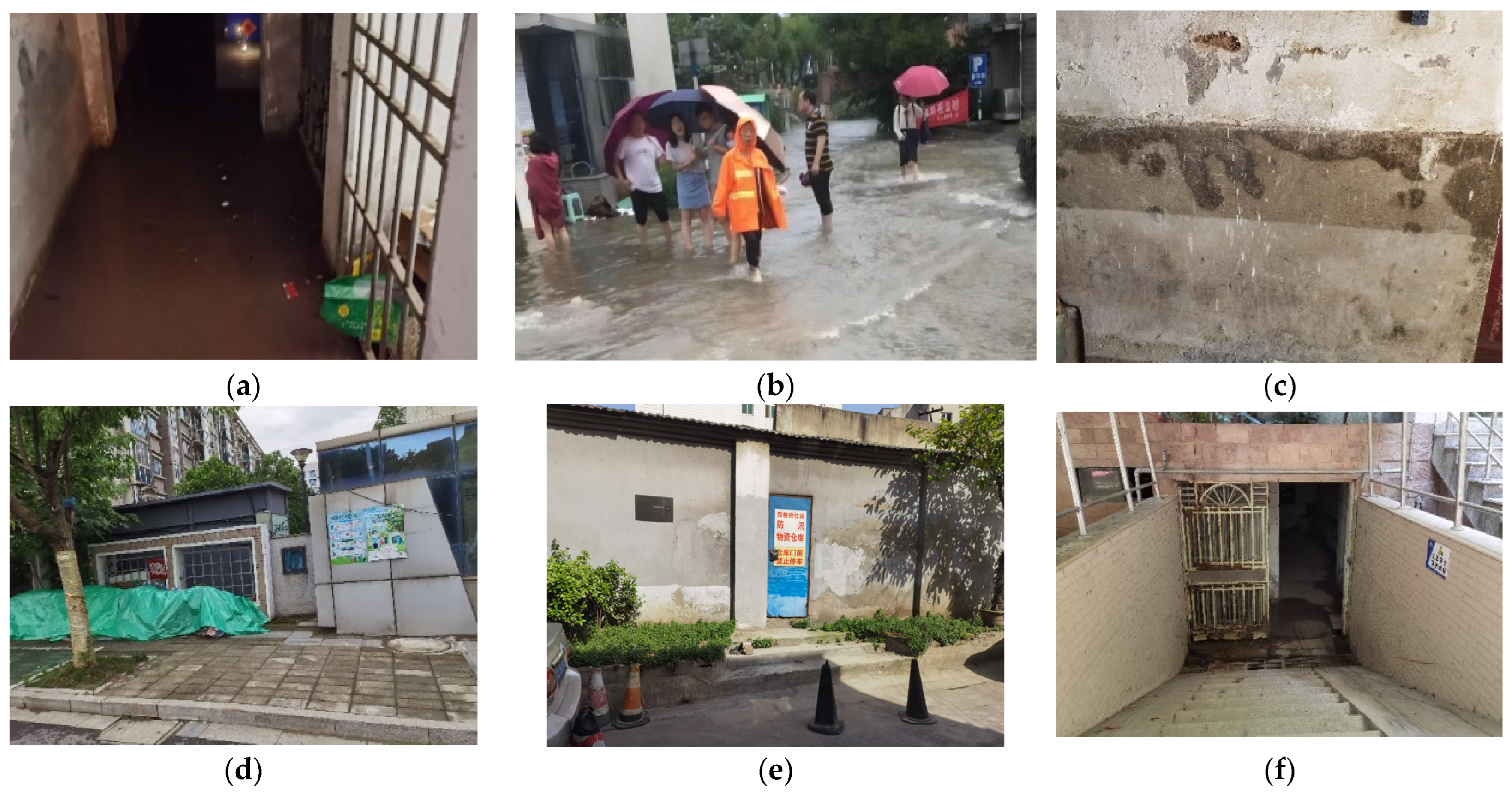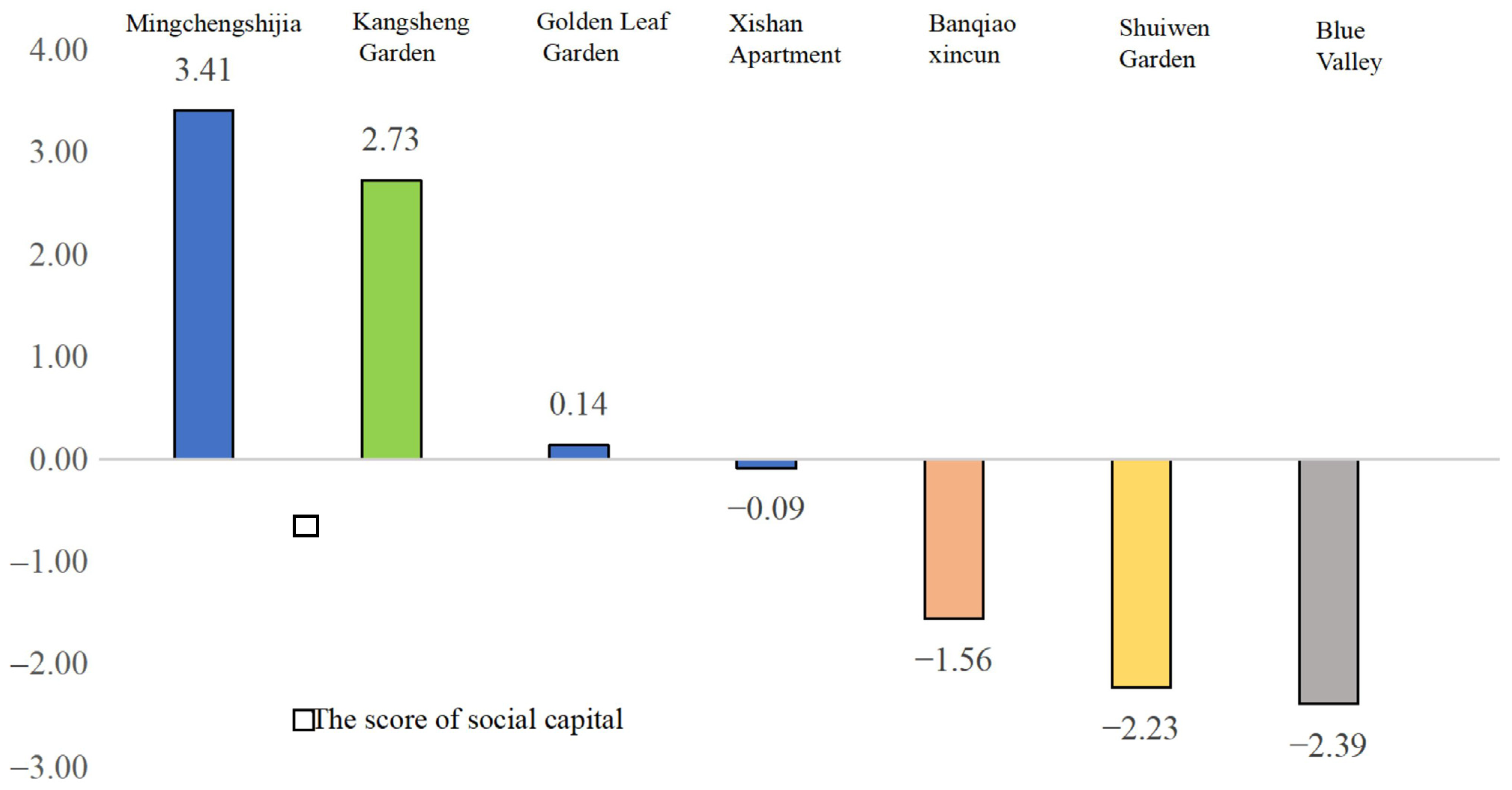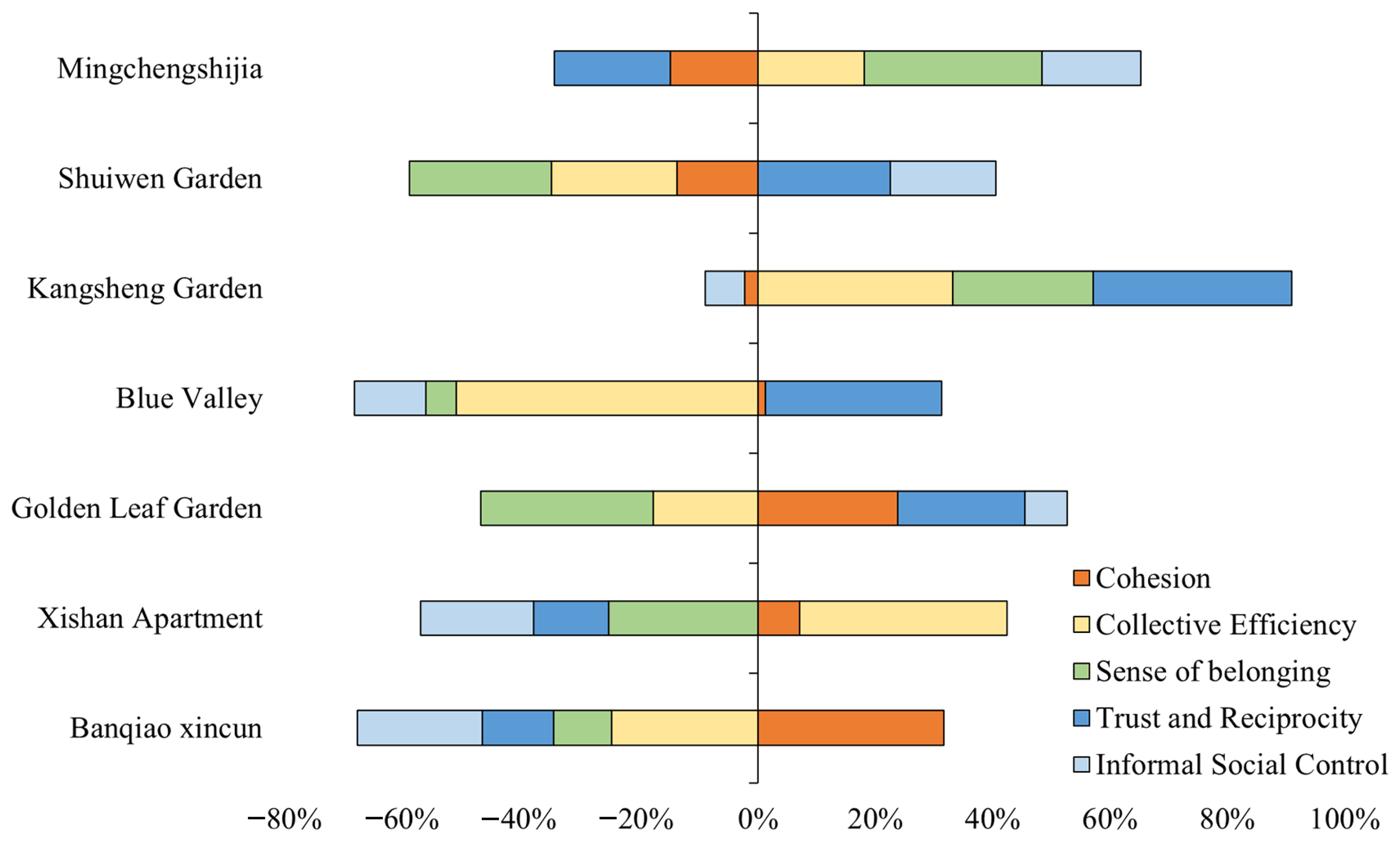The Impact of Social Capital on Community Resilience: A Comparative Study of Seven Flood-Prone Communities in Nanjing, China
Abstract
:1. Introduction
2. Methods
2.1. Study Area and Data
2.2. Variables
2.3. Models
- (1)
- Factor analysis
- (2)
- Multiple regression
3. Results and Discussion
3.1. Social Capital of Different Communities
3.2. Different Dimensions of Social Capital
3.3. Community Resilience Measurement
3.4. Impact of Social Capital on Community Resilience
4. Conclusions and Policy Implications
4.1. Social Capital at the Community Level
4.2. Influencing Factors of Community Resilience
4.3. Policy Implications
Author Contributions
Funding
Institutional Review Board Statement
Informed Consent Statement
Data Availability Statement
Conflicts of Interest
| 1 | Reformed housing was assigned by the government or state-owned enterprises in the pre-reform era and then the occupiers were given the full property rights with very low prices in the reform of the housing system. |
| 2 | Commercial housing in China is developed by both public and private property companies to meet the needs of higher-income groups. The unit size typically ranges from 80 m2 to 200 m2 per unit. |
| 3 | Affordable housing was a government subsidized owner-occupied housing type targeting middle- and low- income families. The unit size usually ranging between 60 m2 and 80 m2 per unit. |
References
- National Bureau of Statistics. China Statistical Yearbook 2022; China Statistics Press: Beijing, China, 2023. [Google Scholar]
- He, S.J.; Liu, Y.T.; Wu, F.L.; Webster, C. Social Groups and Housing Differentiation in China’s Urban Villages: An Institutional Interpretation. Hous. Stud. 2010, 25, 671–691. [Google Scholar] [CrossRef]
- Zheng, S.; Song, Z.; Sun, W. Do affordable housing programs facilitate migrants’ social integration in Chinese cities? Cities 2020, 96, 102449. [Google Scholar] [CrossRef]
- Liu, C.L.; Song, W.X. Perspectives of Socio-Spatial Differentiation from Soaring Housing Prices A Case Study in Nanjing, China. Sustainability 2019, 11, 2627. [Google Scholar] [CrossRef]
- Aldrich, D.P.; Meyer, M.A. Social Capital and Community Resilience. Am. Behav. Sci. 2015, 59, 254–269. [Google Scholar] [CrossRef]
- Wilson, G.A. Community resilience, transitional corridors and macro-scalar lock in effects. Environ. Policy Gov. 2014, 24, 42–59. [Google Scholar] [CrossRef]
- Blaikie, P.; Cannon, T.; Davis, I.; Wisner, B. At Risk, Natural Hazards, People’s Vulnerability and Disasters; Routledge: London, UK, 2004. [Google Scholar]
- Doorn, N.; Gardoni, P.; Murphy, C. A multidisciplinary definition and evaluation of resilience: The role of social justice in defining resilience. Sustain. Resilient Infrastruct. 2018, 4, 112–123. [Google Scholar] [CrossRef]
- Murphy, B.L. Locating social capital in resilient community-level emergency management. Nat. Hazards 2007, 41, 297–315. [Google Scholar] [CrossRef]
- Coleman, J.S. Social Capital in the Creation of Human Capital. Am. J. Sociol. 1988, 94, S95–S120. [Google Scholar] [CrossRef]
- Putnam, R.D. Making Democracy Work: Civic Traditions in Modern Italy; Princeton University Press: Princeton, NJ, USA, 1994. [Google Scholar]
- Putnam, R.D. Bowling Alone: The Collapse and Revival of American Community; Simon and Schuster: New York, NY, USA, 2000. [Google Scholar]
- Lin, N. Social Capital: A Theory of Social Structure and Action; Cambridge University Press: Cambridge, UK, 2002. [Google Scholar]
- FEMA. A Whole Community Approach to Emergency Management: Principles, Themes, and Pathways for Action; Federal Emergency Management Agency: Washington, DC, USA, 2011. [Google Scholar]
- Cutter, S.L.; Burton, C.G.; Emrich, C.T. Disaster Resilience Indicators for Benchmarking Baseline Conditions. J. Homel. Secur. Emerg. Manag. 2010, 7, 51. [Google Scholar] [CrossRef]
- Peacock, W.G.; Van Zandt, S.; Zhang, Y.; Highfield, W.E. Inequities in Long-Term Housing Recovery After Disasters. J. Am. Plan. Assoc. 2014, 80, 356–371. [Google Scholar] [CrossRef]
- Galea, K.S.F.H.N.S. Measuring Capacities for Community Resilience. Soc. Indic. Res. 2010, 99, 227–2472. [Google Scholar]
- Choo, M.; Yoon, D.K. Examining the effects of the local communities’ social capital on disaster response capacity in Seoul, South Korea. Int. J. Disaster Risk Reduct. 2022, 75, 102973. [Google Scholar] [CrossRef]
- Fraser, T. Japanese social capital and social vulnerability indices: Measuring drivers of community resilience 2000–2017. Int. J. Disaster Risk Reduct. 2021, 52, 101965. [Google Scholar] [CrossRef]
- Nakagawa, Y.; Shaw, R. Social capital: A missing link to disaster recovery. Int. J. Mass Emergencies Disasters 2004, 22, 5–34. [Google Scholar] [CrossRef]
- Hausman, A.J.; Hanlon, A.; Seals, B. Social capital as a mediating factor in emergency preparedness and concerns about terrorism. J. Community Psychol. 2007, 35, 1073–1083. [Google Scholar] [CrossRef]
- Karunarathne, A.Y. Geographies of the evolution of social capital legacies in response to flood disasters in rural and urban areas in Sri Lanka. Int. J. Disaster Risk Reduct. 2021, 62, 102359. [Google Scholar] [CrossRef]
- Hawkins, R.L.; Maurer, K. Bonding, Bridging and Linking: How Social Capital Operated in New Orleans following Hurricane Katrina. Br. J. Soc. Work 2009, 40, 1777–1793. [Google Scholar] [CrossRef]
- Shaw, R.; Goda, K. From disaster to sustainable civil society: The Kobe experience. Disasters 2004, 28, 16–40. [Google Scholar] [CrossRef]
- Lo, A.Y.; Xu, B.; Chan, F.K.S.; Su, R. Social capital and community preparation for urban flooding in China. Appl. Geogr. 2015, 64, 1–11. [Google Scholar] [CrossRef]
- Liang, Y.; Jiang, C.; Ma, L.; Liu, L.; Chen, W.; Liu, L. Government support, social capital and adaptation to urban flooding by residents in the Pearl River Delta area, China. Habitat Int. 2017, 59, 21–31. [Google Scholar] [CrossRef]
- Cui, P.; Li, D.Z. A SNA-based methodology for measuring the community resilience from the perspective of social capitals: Take Nanjing, China as an example. Sustain. Cities Soc. 2020, 53, 101880. [Google Scholar] [CrossRef]
- Cutter, S.L.; Ash, K.D.; Emrich, C.T. The geographies of community disaster resilience. Glob. Environ. Change-Hum. Policy Dimens. 2014, 29, 65–77. [Google Scholar] [CrossRef]
- Shahid, M.A.; Bohara, A. Does social capital help in post-disaster recovery? Evidence from the Gorkha earthquake of Nepal. Int. J. Disaster Risk Reduct. 2022, 82, 103359. [Google Scholar] [CrossRef]
- Lyu, M.; Sun, B.Q.; Tian, X.; Wang, Y.Y. How does social capital influence shadow evacuation behavior under rainstorm disaster in China. Saf. Sci. 2023, 162, 106098. [Google Scholar] [CrossRef]
- Zhang, Z.Y.; Yang, A.H.; Wang, Y.X. How do social capital and village-level organizational trust affect farmers’ climate-related disaster adaptation behavior? Evidence from Hunan Province, China. Int. J. Disaster Risk Reduct. 2023, 99, 104083. [Google Scholar] [CrossRef]
- Wickes, R.; Zahnow, R.; Taylor, M.; Piquero, A.R. Neighborhood Structure, Social Capital, and Community Resilience: Longitudinal Evidence from the 2011 Brisbane Flood Disaster. Soc. Sci. Q. 2015, 96, 330–353. [Google Scholar] [CrossRef]
- Taylor, M.; Singleton, S. The communal resource: Transaction costs and the solution of collective action problems. Politics Soc. 1993, 21, 195–214. [Google Scholar] [CrossRef]
- Flora, J.L. Social capital and communities of place. Rural. Sociol. 1998, 63, 481–506. [Google Scholar] [CrossRef]
- Woolcock, M. Social capital and economic development: Toward a theoretical synthesis and policy framework. Theory Soc. 1998, 27, 151–208. [Google Scholar] [CrossRef]
- Jongman, B.; Koks, E.E.; Husby, T.G.; Ward, P.J. Increasing flood exposure in the Netherlands: Implications for risk financing. Nat. Hazards Earth Syst. Sci. 2014, 14, 1245–1255. [Google Scholar] [CrossRef]
- Aerts, J.C.; Botzen, W.J.; Clarke, K.C.; Cutter, S.L.; Hall, J.W.; Merz, B.; Michel-Kerjan, E.; Mysiak, J.; Surminski, S.; Kunreuther, H. Integrating human behaviour dynamics into flood disaster risk assessment. Nat. Clim. Chang. 2018, 8, 193–199. [Google Scholar] [CrossRef]
- Knighton, J.; Hondula, K.; Sharkus, C.; Guzman, C.; Elliott, R. Flood risk behaviors of United States riverine metropolitan areas are driven by local hydrology and shaped by race. Proc. Natl. Acad. Sci. USA 2021, 118, e2016839118. [Google Scholar] [CrossRef] [PubMed]
- Wing, O.E.J.; Lehman, W.; Bates, P.D.; Sampson, C.C.; Quinn, N.; Smith, A.M.; Neal, J.C.; Porter, J.R.; Kousky, C. Inequitable patterns of US flood risk in the Anthropocene. Nat. Clim. Chang. 2022, 12, 156–162. [Google Scholar] [CrossRef]
- McEwen, L.; Holmes, A.; Quinn, N.; Cobbing, P. ‘Learning for resilience’: Developing community capital through flood action groups in urban flood risk settings with lower social capital. Int. J. Disaster Risk Reduct. 2018, 27, 329–342. [Google Scholar] [CrossRef]
- Castro-Correa, C.P.; Ide, P.A.; Vásquez, K.W.; Maldonado, D.M.; Tello, S.P. Transformation of social capital during and after a disaster event: The cases Chañaral and Diego de Almagro, Atacama Region, Chile. Nat. Hazards 2020, 103, 2440. [Google Scholar] [CrossRef]
- Liu, W.M.; Gerber, E.; Jung, S.Y.; Agrawal, A. The role of human and social capital in earthquake recovery in Nepal. Nat. Sustain. 2022, 5, 167. [Google Scholar] [CrossRef]
- Reininger, B.M.; Rahbar, M.H.; Lee, M.; Chen, Z.X.; Alam, S.R.; Pope, J.; Adams, B. Social capital and disaster preparedness among low income Mexican Americans in a disaster prone area. Soc. Sci. Med. 2013, 83, 50–60. [Google Scholar] [CrossRef]
- Tan, J.; Lin, L. Exploring key social capital indicators for disaster preparedness in rural disaster-prone areas: A boosted regression tree approach. Nat. Hazards 2024, 120, 4159–4180. [Google Scholar] [CrossRef]
- Lwin, K.K.; Pal, I.; Shrestha, S.; Warnitchai, P. Assessing social resilience of flood-vulnerable communities in Ayeyarwady Delta, Myanmar. Int. J. Disaster Risk Reduct. 2020, 51, 101745. [Google Scholar] [CrossRef]
- Wickes, R.; Britt, C.; Broidy, L. The resilience of neighborhood social processes: A case study of the 2011 Brisbane flood. Soc. Sci. Res. 2017, 62, 96–119. [Google Scholar] [CrossRef]




| Street | Community | Type | Construction Year | Area (ha) | Floor Area Ratio | Green Ratio (%) | Building |
|---|---|---|---|---|---|---|---|
| Sanhongqiao | Mingchengshijia | Commercial | 2009 | 5.32 | 2 | 36 | High-story |
| Yuhua | Kangsheng Garden | Commercial | 1997 | 10.34 | 1.5 | 45 | Multiple-story |
| Tiexinqiao | Blue Valley | Commercial | 2007 | 2.31 | 1.78 | 40 | Multiple-story |
| Tiexinqiao | Shuiwen Garden | Reform | 1982 | 1.3 | 2 | 35 | Small high-story |
| Xishanqiao | Xishan apartments | Reform | 1996 | 1.86 | 1.82 | 45 | Small high-story |
| Yuhuatai EDZ | Golden Leaf Garden | Affordable | 1990 | 7.04 | 1.6 | 20 | Multiple-story |
| Guxiong | Banqiao Xincun | Reform | 1990 | 2.86 | 2 | 28 | Small high-story |
| Item | Classification | Proportion (%) | Item | Classification | Proportion (%) |
|---|---|---|---|---|---|
| Sex | Male | 43 | Marriage | Married | 59 |
| Female | 57 | Single | 27 | ||
| Age | 0–20 | 3 | Divorced | 2 | |
| 21–40 | 29 | Widow | 12 | ||
| 41–80 | 62 | Hukou Location | Local | 77 | |
| Over 81 | 6 | Migrant | 23 | ||
| Education | Primary school | 37 | Hu Kou | Town | 76 |
| Junior high school | 22 | Countryside | 24 | ||
| High school | 9 | Housing | Self-owned | 86 | |
| Undergraduate | 26 | Rental | 14 | ||
| Postgraduate | 6 | ||||
| Variables | Criterion | Indicator |
|---|---|---|
| Dependent variable: Community resilience | Social Resilience | Resident participation |
| Shelter | ||
| Purchase insurance | ||
| Rainstorm information | ||
| Economic resilience | Reduced expenses | |
| Organizational resilience | Neighborhood help | |
| Committee help | ||
| Government help | ||
| Independent variable: Social capital | Cohesion | Close interaction |
| Resident cooperation | ||
| Resident participation | ||
| Number of greetings | ||
| Neighborhood communication | ||
| Mutual assistance | ||
| Collective Efficiency | Property concern | |
| Committees’ concern | ||
| Government concern | ||
| Trust of committees | ||
| Sense of Belonging | Residence intention | |
| Livability Comfort | ||
| Community members | ||
| Trust and Reciprocity | Problem-solving cooperation | |
| Residents’ trust | ||
| Residents’ mutual assistance | ||
| Trust level | ||
| Informal Social Control | Protection of public health | |
| Acceptance of unethical behavior | ||
| Stopping unethical behavior |
| Factor | Evaluation Index System | Load Factor | Eigenvalue | Variance Contribution Rate (%) | Cumulative Variance Contribution Rate (%) |
|---|---|---|---|---|---|
| F1 Cohesion | Close interaction | 0.698 | 3.313 | 15.060 | 16.060 |
| Resident cooperation | 0.722 | ||||
| Resident participation | 0.700 | ||||
| Number of greetings | 0.461 | ||||
| Neighborhood communication | 0.723 | ||||
| Mutual assistance | 0.699 | ||||
| F2 Collective efficacy | Property concern | 0.846 | 2.976 | 13.060 | 28.589 |
| Committees’ concern | 0.866 | ||||
| Government concern | 0.663 | ||||
| Trust of committees | 0.761 | ||||
| F3 Sense of Belonging | Residence intention | 0.583 | 2.647 | 12.030 | 40.619 |
| Livability | 0.842 | ||||
| Comfort | 0.843 | ||||
| Community members | 0.575 | ||||
| F4 Trust and Reciprocity | Problem-solving cooperation | 0.578 | 2.646 | 12.025 | 52.769 |
| Residents’ trust | 0.646 | ||||
| Residents’ mutual assistance | 0.805 | ||||
| Trust level | 0.623 | ||||
| F5 Informal Social Control | Protection of public health | 0.686 | 1.567 | 7.124 | 59.769 |
| Acceptance of unethical behavior | 0.696 | ||||
| Stopping unethical behavior | 0.492 |
| Factor | Evaluation Index System | Load Factor | Eigenvalue | Variance Contribution Rate (%) | Cumulative Variance Contribution Rate (%) |
|---|---|---|---|---|---|
| F1 Organization resilience | Neighborhood help | 0.353 | 1.770 | 2.122 | 22.122 |
| Committee help | 0.871 | ||||
| Government help | 0.836 | ||||
| F2 Social resilience | Resident participation | 0.655 | 1.566 | 19.576 | 41.698 |
| Shelter | 0.611 | ||||
| Purchase insurance | 0.390 | ||||
| Rainstorm information | 0.738 | ||||
| F3 Economic resilience | Reduced expenses | 0.899 | 1.135 | 14.189 | 55.887 |
| ModelI | Model II | Model III | ||
|---|---|---|---|---|
| Individual | Age X1 | −0.002 * (−1.69) | −0.003 ** (−2.44) | |
| Attributes | Gender X2 | 0.039 (1.00) | −0.006 (−0.17) | |
| Education X3 | 0.013 (0.896) | 0.009 (0.74) | ||
| Risk Perception | Increased savings X4 | −0.150 *** (−2.78) | −0.111 ** (−2.35) | |
| Property transfer X5 | 0.027 (0.50) | 0.019 (0.41) | ||
| Community preparation X6 | −0.165 *** (−2.57) | −0.01 (−0.19) | ||
| Social Capital | Cohesion X7 | 0.051 *** (3.35) | 0.070 *** (4.08) | |
| Collective efficacy X8 | 0.147 *** (9.65) | 0.124 *** (6.93) | ||
| Sense of belonging X9 | 0.033 ** (2.17) | 0.039 ** (2.21) | ||
| Trust and reciprocity X10 | 0.020(1.33) | 0.023 (1.27) | ||
| Informal social control X11 | 0.054 *** (3.56) | 0.046 *** (2.72) | ||
| Constant | 0.449 *** (3.34) | 0.000 (0.00) | 0.271 ** (2.24) | |
| Adjusted R2 | 0.152 | 0.306 | 0.371 | |
| F value | 7.10 *** | 24.70 *** | 12.47 *** |
Disclaimer/Publisher’s Note: The statements, opinions and data contained in all publications are solely those of the individual author(s) and contributor(s) and not of MDPI and/or the editor(s). MDPI and/or the editor(s) disclaim responsibility for any injury to people or property resulting from any ideas, methods, instructions or products referred to in the content. |
© 2024 by the authors. Licensee MDPI, Basel, Switzerland. This article is an open access article distributed under the terms and conditions of the Creative Commons Attribution (CC BY) license (https://creativecommons.org/licenses/by/4.0/).
Share and Cite
Chen, Y.; Liu, H.; Lin, S.; Wang, Y.; Zhang, Q.; Feng, L. The Impact of Social Capital on Community Resilience: A Comparative Study of Seven Flood-Prone Communities in Nanjing, China. Land 2024, 13, 1145. https://doi.org/10.3390/land13081145
Chen Y, Liu H, Lin S, Wang Y, Zhang Q, Feng L. The Impact of Social Capital on Community Resilience: A Comparative Study of Seven Flood-Prone Communities in Nanjing, China. Land. 2024; 13(8):1145. https://doi.org/10.3390/land13081145
Chicago/Turabian StyleChen, Yi, Hui Liu, Shuchang Lin, Yueping Wang, Qian Zhang, and Liaoling Feng. 2024. "The Impact of Social Capital on Community Resilience: A Comparative Study of Seven Flood-Prone Communities in Nanjing, China" Land 13, no. 8: 1145. https://doi.org/10.3390/land13081145





